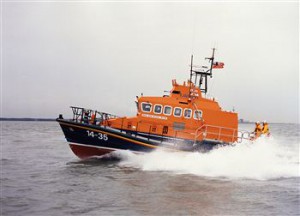
THE RNLI launched, on average, 20 lifeboats in Scotland each week in 2011 according to the charity’s official statistics released today, (Tuesday 7 February)
The charity had another busy year – it was the RNLI’s 6th busiest year in Scotland – with 1,006 launches in Scotland during which 847 people were rescued.
This compares with 2010 where there were 1011 launches with 916 people being rescued.
The busiest lifeboat station in Scotland was Broughty Ferry, where the RNLI’s two lifeboats launched a total of 104 times, a record breaking year for the volunteers at the station on the outskirts of Dundee. More than a third of those launches were during the hours of darkness.
The Broughty Ferry crew also spent a total of 1,151 hours at sea in 2011. This includes the time spent exercising to ensure they, like all RNLI crews, are trained to the highest possible standards.
The station spending the most time on services and exercises was Dunbar, where 2,327 hours were spent at sea. Altogether the 45 Scottish lifeboat crews spent 33,888 hours on their lifeboats.
The busiest inshore lifeboat was at the RNLI’s Queensferry station, near Edinburgh, with 62 services during which they assisted 117 people including 13 under the age of 18.
The stations at Campbeltown, Stornoway, Kessock, Kippford and Islay recorded more than 50% of their services in darkness, while the stations at Mallaig, Aberdeen, Lerwick, St Abbs and Barra spent half of their services in the dark.
Skills
The RNLI’s Divisional Inspector in Scotland, Paul Jennings, says, “The annual statistics reveal once again the devotion to duty by our volunteer crews throughout Scotland.
“Apart from the shouts, the crews spend a great deal of time in exercising and improving their skills so that they are in a position to help anyone in all types of weather and in all types of situation.
“It is particularly notable that during December we had four spells of stormy weather with winds from force 10 to 12 and yet our crews still launched, as they always do whatever the weather.
“On 8 December lifeboats launched at Buckie in hurricane conditions, while Troon, Peterhead, Oban and Peterhead also launched in gale to severe gales for a variety of emergencies.”
Almost 17% (170) of lifeboat call-outs were attributed to machinery failure. There was an increase in the number of people who were in danger after being cut off from the tide, up from 24 in 2010, to 35 in 2011.
Boats with fouled propellers resulted in 63 call-outs, compared with 44 the previous year and 27 in 2009.
RNLI Operations Director, Michael Vlasto, says, “It’s essential for us to look behind the figures as the charity puts a lot of effort into helping prevent emergencies in the first place. We do this through our safety education programmes and campaigns – another of the ways we aim to save lives at sea.
“When you realise that machinery failure is the main cause of nearly one fifth of lifeboat launches you can see why we’re keen that all boat users, whether commercial or recreational, make sure they maintain their vessels properly.
“The RNLI has mechanics at every lifeboat station – we’d never ask our volunteers to put to sea without knowing our vessels are in a seaworthy condition – and nor should anyone else.”
He added most of the fouling of propellers was caused by discarded ropes and nets, which was surprising and disappointing given the importance attached to environmental protection.